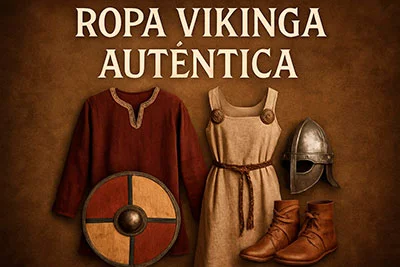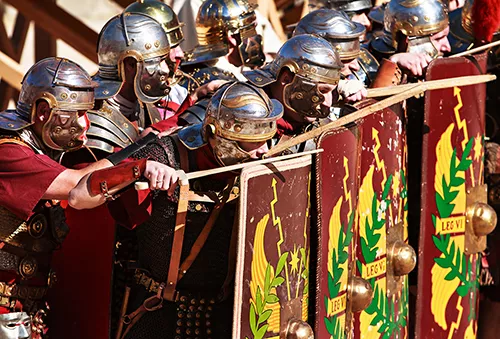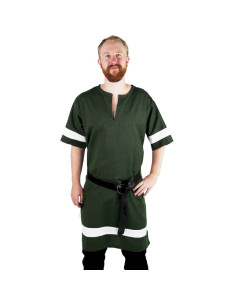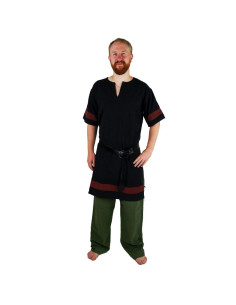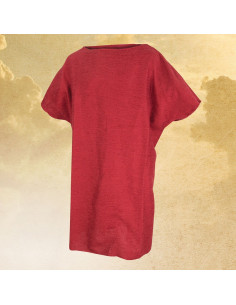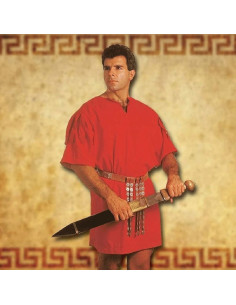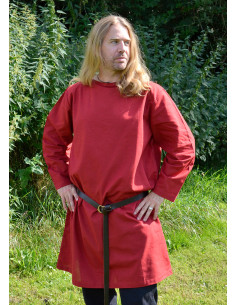Roman tunics
Design and Authenticity: Why Choose Our Roman Tunics
The Roman Tunics we offer combine design inspired by Antiquity with finishes tailored for modern use. Each model, from the Roman Gladiator Tunic to the blue Roman tunic with embroidery, has been crafted to convey the classical aesthetic: simple cuts, natural draping, and details such as embroidery or stripes that evoke ranks and military styles. Our catalog emphasizes both historical appearance and comfort, making the garment suitable for reenactments, theater, events, and celebrations.
Buying Authentic Roman Tunics Online in our store guarantees pieces with a carefully balanced quality-price ratio. Designs vary in length, sleeve, and ornamentation to meet different needs: the red Roman Legionary Tunic and the Black-Red Roman Tunic offer presence and drama, while the long-sleeved red cotton Roman tunic focuses on softness and warmth. If you seek visual authenticity without sacrificing comfort, our options are designed precisely for that.
Materials and Craftsmanship: Cotton, Embroidery, and Faithful Fabrics
The available Roman Tunics include a selection of materials designed for various uses. Cotton appears in pieces like the long-sleeved red Roman tunic and the Roman Legionary Tunic, providing softness, breathability, and ease of maintenance. For more ornate models, such as the blue Roman tunic with embroidery or the long-sleeved Roman tunic with red embroidery, we use yarns and sewing techniques that enhance the motifs without sacrificing durability. The Greek cotton tunic and the Norman courtier tunic showcase fabric variants suited for historical reenactment and stage design.
The tailoring prioritizes reinforced seams at stress points and finishes that withstand repeated use. If you need a tunic designed for stage steps or photo sessions, our embroidered and lined pieces offer a balance between aesthetics and usability. Raw materials are selected so that the fall and volume recall classical references, while the internal structure facilitates adjustments and combinations with other elements such as belts and cloaks.
Sizes, Fit, and Practical Guide to Choosing Your Roman Tunics
Choosing the correct size is key for the Roman Tunic to look comfortable and authentic. Classic tunics usually offer straight cuts or slightly fitted at the shoulders, with freedom from the waist down; therefore, we recommend measuring chest, shoulders, and desired length before selecting. Models like the Green-White Roman Tunic or the Medieval-Red Roman Tunic can be worn both loose or slightly tailored, depending on the aesthetic you seek. Our product sheets indicate approximate measurements and how to take yours, so you can decide between standard sizes or sizes designed to layer light armor.
Consider the use: if you are going to wear a Roman Gladiator Tunic along with protections or armor pieces, choose a size with more room in the shoulders and torso. For events where the look must be more elegant, such as the Norman courtier tunic, a more defined fit at the waist and shoulders is more appropriate. If you hesitate between two sizes, opting for the larger one facilitates movement and additional layers without losing the classic silhouette.
Uses and Occasions: From Historical Reenactment to Shows and Parties
Roman Tunics are versatile and adapt to multiple contexts. For historical reenactment and light combat, we recommend sturdy and functional-cut models, such as the Roman Gladiator Tunic or the Roman Legionary Tunic, combined with appropriate belts and protectors. In theater and film, options with embroidery and intense colors — for example, the blue Roman tunic with embroidery or the Black-Red Roman Tunic — offer stage presence and convey hierarchy and visual character from the front row.
For celebrations, carnival, or photo sessions, the color variety and finishes make it easy to create different looks: the Green-White Roman Tunic brings freshness, the Medieval-Red Roman Tunic adds drama, and the Greek cotton tunic offers a more flowing and elegant alternative. All these options are designed to be purchased and used easily: they can be complemented with sandals, cloaks, or metal accessories to achieve a striking and authentic result at any event.
Care and Preservation to Make Your Roman Tunics Last Longer
Maintaining Roman Tunics in good condition extends their useful life and preserves colors and embroidery. For cotton pieces, like the long-sleeved red Roman tunic, we recommend washing at low temperature and drying in the shade to avoid color loss. Models with embroidery (blue Roman tunic with embroidery, long-sleeved Roman tunic with red embroidery) require more delicate treatment: gentle hand wash or delicate cycle, and ironing inside out at medium temperature to protect the motifs. Avoid harsh bleaches and check the specific instructions on each product sheet.
Storage is also important: keep tunics in breathable covers and avoid hanging them near heat sources to prevent deformation. For stage-use pieces that will be exposed to sweat or makeup, perform spot cleaning after each event. Following these guidelines, your tunics will maintain their appearance and structure, ready to use on multiple occasions and preserve your investment in garments with historical appearance and careful craftsmanship.
What materials are Roman Tunics in the collection usually made of?
Our collection mainly includes high-quality cotton for comfort and breathability, ideal in models like the long-sleeved red Roman tunic and the Roman Legionary Tunic. We also have pieces that incorporate heavier fabrics or blends for more body and drape, and with embroidered details in durable yarn in models such as the blue Roman tunic with embroidery and the long-sleeved Roman tunic with red embroidery. For each product, we indicate the exact composition in the sheet, which helps choose according to use and tactile feel.
How do I choose the correct size for a Roman Tunic?Choose the size by measuring chest, shoulders, and desired length from shoulder to knee or ankle, depending on the cut. If you will wear cloaks or any protective piece, add centimeters to chest and shoulder circumference. Product sheets offer measurement guides and specific recommendations for each model, such as the Roman Gladiator Tunic (shorter and functional) or the Norman courtier tunic (fitted and elegant). If you hesitate between two sizes, opting for the larger one usually guarantees mobility and versatility.
Are the available Roman Tunics historically accurate?Our Roman Tunics seek a balance between visual fidelity and modern functionality. Many models reproduce cuts, colors, and ornamental elements inspired by historical references, but we adapt seams and finishes for greater durability and contemporary comfort. For professional productions or strict reenactments, we recommend consulting detailed sheets and opting for pieces with simpler finishes and natural materials. In any case, in our online store you will find options that prioritize historical appearance without sacrificing the practicality needed today.
Can I use a Roman Tunic for reenactment with armor or light combat?Yes, several of our pieces are designed to be combined with protective elements. The Roman Legionary Tunic and the Roman Gladiator Tunic allow easy layering with straps and light protectors; select a size with room in shoulders and torso to facilitate movement. For moderate contact combat, it is advisable to use additional protection over the tunic and avoid very fragile fabrics or delicate embroidery, which could be damaged by friction. Check each product description to verify suitability according to use.
How to combine Roman Tunics with accessories for a complete look?For a coherent outfit, add wide belts, decorative cingula, cloaks in contrasting tones, and sandals or boots appropriate to the recreated period. A helmet and armlets will give presence to the Roman Gladiator Tunic, while a cloak and a simpler belt work well with the Green-White Roman Tunic or the Norman courtier tunic. Leather and bronze accessories accentuate the historical appearance; choose pieces proportional to the length and volume of the tunic to maintain aesthetic balance and comfort.
How to care for Roman Tunics with embroidery and intense colors?To preserve embroidery and vibrant tones, wash by hand or on a delicate cycle with cold water and mild detergent. Dry in the shade and iron inside out at medium temperature to protect embroidered motifs. Avoid prolonged soaking and bleaches. If the piece has appliqués or metal adornments, remove them if possible before washing or clean the area more carefully. Storing in breathable covers helps maintain colors and shape over time.
What are the differences between a Gladiator Tunic and a Legionary Tunic?The Roman Gladiator Tunic is usually shorter and designed to guarantee maximum mobility, with simple cuts and fit intended for stage action. The red Roman Legionary Tunic or the Roman Legionary Tunic, on the other hand, tend to be mid-length and more sober in cut, designed to be combined with military belts and cloaks; they prioritize a uniform and functional aesthetic typical of troops. The choice depends on use: stage combat, military reenactment, or staging.
Explore now our selection of Roman Tunics: add to your cart the piece you are looking for, from the Roman Gladiator Tunic to the blue Roman tunic with embroidery. Buy Authentic Roman Tunics Online and get quality, authenticity, and style ready for your next performance or event.

